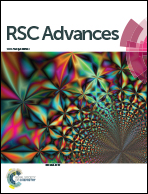An improved large-scale prediction model of CYP1A2 inhibitors by using combined fragment descriptors†
Abstract
CYP1A2, an important member of the cytochromes P450 (CYPs) superfamily, is involved in the metabolism or bioactivation of many clinical drugs and precarcinogens. Thus, accurate prediction of CYP1A2 inhibitors is of great importance in early drug discovery and cancer prevention. In this study, a dataset of more than 12 000 structurally diverse compounds was used to develop prediction models by a support vector machine (SVM). By combining two types of fragment descriptors, i.e. Molecular Hologram and MACCS descriptors, an improved radial basis function (RBF)-based SVM model was obtained, of which the accuracies (ACCs), sensitivities (SENs), specificities (SPEs), and Matthews correlation coefficients (MCCs) were 90.95%, 92.40%, 89.70%, 0.8191 for 6396 training samples, and 83.14%, 85.17%, 81.41%, 0.6638 for 6395 test samples, respectively. The prediction capability of the SVM model obtained was further validated by an independent dataset of 2581 samples with geometric mean (G-mean) based accuracy of 70.67%. The results indicate that the combination of the two types of fragment descriptors is an extremely efficient method for eliciting the key structural features of CYP inhibitors, and thus can be employed to large-scale virtual screening of inhibitors of CYP isoforms.


 Please wait while we load your content...
Please wait while we load your content...